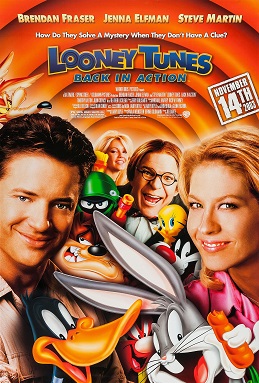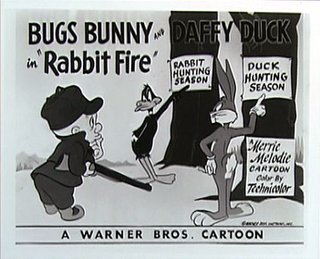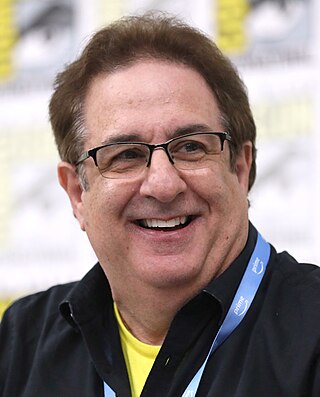
Looney Tunes is an American animated franchise produced and distributed by Warner Bros. It began as a series of short films that originally ran from 1930 to 1969, concurrently with its partner series Merrie Melodies, during the golden age of American animation. Following a revival in the late 1970s, new shorts were released as recently as 2014. The two series introduced a large cast of characters, including Bugs Bunny, Daffy Duck, and Porky Pig. The term Looney Tunes has since been expanded to also refer to the characters themselves.

Daffy Duck is a fictional character created by animators Tex Avery and Bob Clampett for Leon Schlesinger Productions. Styled as an anthropomorphic black duck, he has appeared in cartoon series such as Looney Tunes and Merrie Melodies, in which he is usually depicted as a foil for either Bugs Bunny, Porky Pig or Speedy Gonzales. He was one of the first of the new "screwball" characters that emerged in the late 1930s to replace traditional everyman characters who were more popular earlier in the decade, such as Mickey Mouse, Porky Pig, and Popeye.

Porky Pig is an animated character in the Warner Bros. Looney Tunes and Merrie Melodies series of cartoons. He was the first character created by the studio to draw audiences based on his star power, and the animators created many critically acclaimed shorts featuring the character. Even after he was supplanted by later characters, Porky continued to be popular with moviegoers and, more importantly, the Warners directors, who recast him in numerous everyman and sidekick roles.

Merrie Melodies is an American animated comedy short film series distributed by Warner Bros. Pictures. It is the companion series to Looney Tunes, and featured many of the same characters. It originally ran from August 2, 1931, to September 20, 1969, during the golden age of American animation, though it was revived in 1979, with new shorts sporadically released until June 13, 1997. Originally, Merrie Melodies placed emphasis on one-shot color films in comparison to the black-and-white Looney Tunes films. After Bugs Bunny became the breakout character of Merrie Melodies and Looney Tunes transitioned to color production in the early 1940s, the two series gradually lost their distinctions and shorts were assigned to each series randomly.

Looney Tunes: Back in Action is a 2003 American live-action/animated comedy film produced by Warner Bros. Feature Animation and distributed by Warner Bros. Pictures. It is the second theatrical feature film in the Looney Tunes franchise, and was directed by Joe Dante from a screenplay by Larry Doyle. Brendan Fraser, Jenna Elfman, and Steve Martin star in the film; Timothy Dalton, Heather Locklear, and Bill Goldberg appear in supporting roles, while Joe Alaskey leads the voice cast. Its plot, which parodies action and spy film conventions, follows Bugs Bunny and Daffy Duck (Alaskey) as they become intertwined in a plot by the ACME Chairman (Martin) to transform the world's population into subservient monkeys using the Blue Monkey diamond. They accompany aspiring stuntman DJ Drake (Fraser) and Warner Bros. executive Kate Houghton (Elfman) on their journey to thwart the Chairman's plot, which doubles as a mission to rescue the former's abducted father, Damian (Dalton).

Warner Bros. Animation Inc. is an American animation studio which is part of the Warner Bros. Television Studios, a division of Warner Bros., which is a subsidiary of Warner Bros. Discovery and serves as the animation division and label of Warner Bros.

Rabbit Fire is a 1951 Looney Tunes cartoon starring Bugs Bunny, Daffy Duck, and Elmer Fudd. Directed by Chuck Jones and written by Michael Maltese, the cartoon is the first in Jones' "hunting trilogy"—the other two cartoons following it being Rabbit Seasoning and Duck! Rabbit, Duck! It is also the first cartoon to feature a feud between Bugs and Daffy. Produced by Edward Selzer for Warner Bros. Cartoons, Inc., the short was released to theaters on May 19, 1951 by Warner Bros. Pictures and is often considered among Jones' best and most important films.

Daffy Duck's Quackbusters is a 1988 animated compilation film featuring classic Warner Bros. Cartoons shorts and animated bridging sequences, starring Daffy Duck. The film was released to theaters by Warner Bros. on September 24, 1988. It was the final theatrical production in which Mel Blanc provided the voices of the various Looney Tunes characters before his death in July 1989.

Jeffrey Bergman is an American voice actor and impressionist who has provided the modern-day voices of various classic cartoon characters, most notably with Looney Tunes and Hanna-Barbera.

The Bugs Bunny/Road Runner Movie is a 1979 American animated comedy package film directed by Chuck Jones, consisting of a compilation of classic Looney Tunes/Merrie Melodies shorts and newly animated bridging sequences hosted by Bugs Bunny. The bridging sequences, which had been produced in 1978, show Bugs at his home, which is cantilevered over a carrot-juice waterfall. The film was released to celebrate the 40th anniversary of Bugs Bunny.

(Blooper) Bunny is a Merrie Melodies animated short film directed by Greg Ford and Terry Lennon, with music by George Daugherty, produced in 1991 by Warner Bros. Animation. Featuring the voice talents of Jeff Bergman and Gordon Hunt, the short is a parody of some of the specials produced for Bugs Bunny's 50th anniversary the previous year. The short never received its intended theatrical release and was shelved for six years. It was finally given a television premiere on June 13, 1991, after Cartoon Network discovered the film sitting unseen in the vaults. It is featured on the Looney Tunes Golden Collection: Volume 1 as of 2003.

A Star Is Bored is a 1956 Warner Bros. Looney Tunes cartoon, directed by Friz Freleng. The short was released on September 15, 1956, and stars Bugs Bunny and Daffy Duck. The cartoon expands upon the rivalry depicted between Bugs and Daffy, in such films as Chuck Jones' 1951 short Rabbit Fire, this time placing the action in a show-biz setting. In this 7-minute short, Daffy must double for Bugs in any slapstick that Warners deems too dangerous for its top star. After each disaster, Daffy shouts "MAKEUP!". The director directing the scenes has an Erich Von Stroheim accent.

This Is a Life? is a 1955 Warner Bros. Merrie Melodies animated cartoon directed by Friz Freleng, written by Warren Foster, and produced by Edward Selzer, with music directed by Milt Franklyn. The short was released on July 9, 1955, and stars Bugs Bunny. The voices were performed by Mel Blanc, Arthur Q. Bryan, and June Foray in her first work for Warner Bros. This is one of the few Bugs Bunny cartoons whose title does not contain Bugs, bunny, rabbit/wabbit or hare.

Elmer J. Fudd is an animated cartoon character in the Warner Bros. Looney Tunes/Merrie Melodies series and the archenemy of Bugs Bunny. His aim is to hunt Bugs, but he usually ends up seriously injuring himself and other antagonizing characters. He speaks in an unusual way, replacing his Rs and Ls with Ws, so he often refers to Bugs Bunny as a "scwewy" or "wascawwy (rascally) wabbit". Elmer's signature catchphrase is, "Shhh. Be vewy vewy quiet, I'm hunting wabbits", as well as his trademark laughter.

Daffy Duck for President is a children's book, published by Warner Bros. and the United States Postal Service in 1997 to coincide with the release of the first Bugs Bunny U.S. postage stamp. The book was written and illustrated by Chuck Jones, edited by Charles Carney, and art directed by Allen Helbig.

The Looney Tunes Show is an American animated sitcom produced by Warner Bros. Animation, and aired on Cartoon Network for two seasons from May 3, 2011, to November 2, 2013. The series differed from others featuring characters from the Looney Tunes, by focusing on stories conformed around a sitcom format involving the characters of Bugs Bunny and Daffy Duck, who live a surburban life together within a neighborhood of fellow cartoon neighbors, dealing with various issues in their own way. Both the characters from the Looney Tunes, as well as the Merrie Melodies theatrical cartoon shorts, were given a 21st century update, with episodes also including a musical short; the first series also included computer-animated shorts involving new antics between Wile E. Coyote and the Road Runner.

Bugs Bunny's 3rd Movie: 1001 Rabbit Tales is a 1982 animated comedy film by Friz Freleng. It combines classic Warner Bros. cartoon shorts with new animation, with Bugs Bunny serving as the story host.

Daffy's Rhapsody is a 2012 animated Looney Tunes short film featuring the characters Daffy Duck and Elmer Fudd. Directed by Matthew O'Callaghan and written by Tom Sheppard, the film is an adaptation of the song of the same name which was sung by Mel Blanc and recorded in the 1950s by Capitol Records. It also marked the return of Daffy Duck into his original screwball personality after decades of being miscast as a greedy, self-centered character in most of his post-1940s appearances since the Bugs Bunny short Rabbit Fire (1951). Daffy's Rhapsody was first shown in theaters before Warner Bros.' feature-length film Journey 2: The Mysterious Island. Unlike the previous Looney Tunes 3-D shorts, Daffy's Rhapsody has not yet been released on home media. In 2016, the official Warner Bros. Animation uploaded the short to Google but eventually removed it, leaving unofficial uploads of the short being available. It took until 2021 for the short to be officially available to purchase on Stars of Space Jam: Looney Tunes Collection.

Looney Tunes Cartoons is an American animated television series developed by Pete Browngardt and produced by Warner Bros. Animation, based on the characters from Looney Tunes and Merrie Melodies. The series made its worldwide debut at the Annecy International Animation Film Festival on June 10, 2019, and premiered on HBO Max on May 27, 2020.


















